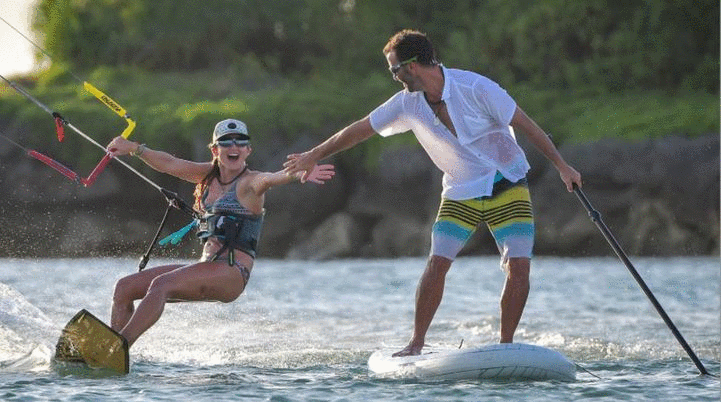Wind Foiling - The Idiot’s Guide
- Romain
- Sep 24, 2018
- 4 min read
Ben Profitt from windsurfing.tv has been trying out wind foiling for the first time and he had the brilliant idea to document it on video to give you an idea of what you should expect when you give windsurf foiling a try for the first time:
All the new sensations, excitement, and experiences you will go through.
Part 1: The first steps
In this video we see the common surprises you normally go through when learning how to foil:
It’s difficult to carry the board to the water
It’s difficult to control the first flights
Learn the pumping technique to fly early
First foiling jibes
First acceleration once you have sustained flights
Foil windsurfing offers you brand new flying sensations with a mix of joy, fun, excitement, and and it gets your adrenaline pumping!
This comment from Ben summarizes it all:
“That was fun, man! You start to go higher and higher and all the sudden the foil comes out and it drops. I was in 5.3m and only 15 knots of wind and I was screaming like a little girl!”
When you learn windsurfing on a hydrofoil, you rediscover the joy of trying new tricks, just like you did when you started windsurfing, like the joy of almost nailing your first jibe!
Here is a summary of the key learnings from Ben’s first windfoiling session:
Boots will be useful for most people in case you kick the foil.
Don’t forget to put on an uphaul line! You have maybe not used it for many years, but you should put it back on your rig. Uphauling is definitely recommended at the beginning, as waterstarting increases your chances to kick the foil as it’s easy to forget the large fin under the water.
Playing with the weight: The foil is quite stable when in the air, you just need to play with the pitch of the board by transferring your weight from the back (to lift the foil) to the front to stabilise the pitch. (Read also: 6 useful tips to improve your balance)
Ben joked about the foiling jibe: double loops and push loops are fine, but the foiling jibe was really scary!
Part 2: Cracking the foiling jibe
“Oh my god! It’s 12 to 14 knots of wind and I’m so, so excited. Weird, weird, weird!”
The next video highlights the excitement people have after trying out wind foiling for the first time: The sensations are so amazing that you can’t wait for another “light wind” day where you can improve your windfoiling skills.
This is the beauty of the foil: it starts getting really fun at 12 knots and this is the reason foiling enables you to multiply your time out on the water, instead of sitting on the beach and waiting for the wind to pick back up.
The goal of the day was to crack the foiling jibe, which is really not that easy.
The conditions for this attempt were almost perfect: flat water, 15 knots, 5.6m sail and the AFS carbon foil.
After several failed attempts, Ben finally get through the jibe and came up with some helpful tips:
Feet placement on the board is crucial to get foiling through the jibe. He finds out that placing the back foot in the middle of the board works best. If you put it too much on the rail, the board flips and you fall off.
You also need to find the balance point: not too far on the back as the board will get to high and collapse, and not too forward as you will then stop flying.
The front foot should go in the front strap as soon as possible once you have made the turn and switched the position of your feet.
The big breakthrough was that the outside foot (which you push in to do the jibe with) should move to the middle of the board after the turn and your new back foot should also move to the middle right after. This was the key to the foiling jibe, according to Ben.

Foiling Jibe by Ben Profitt
Ben had also had great advice when it comes to safety:
If you really prefer to waterstart, you need to make sure not to kick the foil. A good trick Ben gave us is to waterstart from the front of the board, and even with the clew first, so you keep your distance from the back of the board and the foil.
When you fall off, hold onto the boom and fall with the rig. It may sound strange, especially because it is the opposite of windsurfing habits where you try to avoid the sail when falling, but foiling with the sail actually keeps you away from the hydrofoil and minimises your chances to hit it.
Two big key points that I have after watching these videos:
Once more, people trying wind foiling for the first time are amazed about the new sensations it gives, and they get easily addicted to it and eager to test it again right away .
Easy to learn: You can see that Ben is getting very comfortable foiling in a straight line after only 2 sessions, and he even tried some jumps. Ben is, of course, a professional windsurfer and he probably makes it look easier than it actually is, but the fact is that he went from being a total foil-beginner to having sustained flights at a high speed with foiling jibes in only two sessions. This shows that you can really crack your first sustained flights after just a few sessions.
Leave us a comment below if you agree with these advice or if you have any other tips and tricks. We'd love to hear from you.
For Ben at least it's mission accomplished, he cracked the foiling jibe, and his excitement shows that he is clearly foil-addicted. Looking forward to seeing the idiot’s guide to foiling – part 3, this is super entertaining!
Well done Ben!















Comments